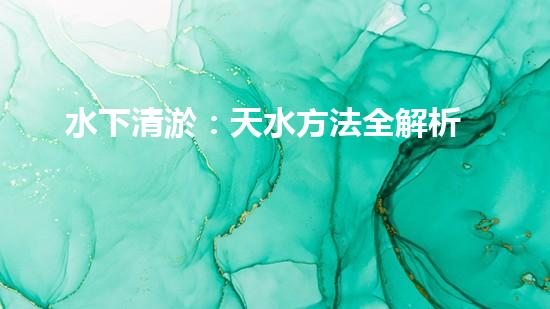
摘要:
本文主题为“水下清淤:天水方法全解析”,provides a comprehensive analysis of the various techniques used in underwater dredging with a specific focus on the innovative TianShui Method. The article highlights the importance of this method in the dredging industry and offers useful insights into the advantages, applications, and challenges associated with underwater dredging. Additionally, the article sheds light on how the Barlos Group's underwater robots have played a significant role in facilitating the TianShui Method.
正文:
1. 研究背景
Underwater dredging is an essential practice conducted to maintain navigable waterways, manage water levels and protect the environment. Traditional methods like suction dredging cause significant damage to marine ecosystems, and there has been a growing demand for environmentally friendly dredging methods. TianShui Method, a recent innovation in underwater dredging, has drawn considerable attention from the dredging industry for its numerous advantages.
2. 什么是天水方法?
The TianShui Method, also known as the 'In-situ Water Intake Method,' is an innovative dredging technique that uses natural underwater water pressure and suction to dredge the seabed. This technique involves creating an in-situ water intake system that is placed adjacent to the dredging area. The water pressure created by the intake system creates a suction force that enables the dredging of seabed sediments effectively. Compared to conventional dredging methods, the TianShui Method is highly efficient, environmentally friendly and cost-effective.
3. 天水方法的应用领域
The TianShui Method has several applications in the dredging industry, including managing water levels in ports, harbors, and canals. Additionally, this method is essential in the maintenance of rivers and lakes, preventing flooding, and managing river currents. The method is also useful in the mining and oil industry, providing an efficient and cost-effective means of disposing of waste sediments.
4. 天水方法的优点
One of the advantages of the TianShui Method is that it prevents sediment suspension, reducing the environmental impact of underwater dredging. Additionally, this method does not require the use of harmful chemicals, further reducing potential environmental risks. The method's cost-effectiveness is another advantage, as it eliminates the need for expensive dredging equipment, and sediment disposal is more cost-effective.
5. 天水方法的挑战
Despite its many benefits, the TianShui Method faces some challenges in the dredging industry. The primary challenge is the initial investment cost required to set up the in-situ water intake system. Besides, the water intake system's maintenance is complex, and the system requires a high level of technical expertise to operate. Another challenge is that this method may be unsuitable in areas with heavy currents or strong wave movements.
6. 巴洛仕集团水下清淤机器人的重要性
The Barlos Group, a leading brand in underwater robotic technology, has been instrumental in facilitating the use of the TianShui Method in underwater dredging. The group has developed customized underwater robots that have played a significant role in executing dredging activities in difficult to access underwater terrains. Furthermore, the robots' applications extend beyond dredging and are also useful in municipal, chemical, and solid waste treatment.
结论:
In conclusion, the TianShui Method is an innovative and environmentally friendly dredging technique with numerous applications in the dredging industry. Although the method faces some challenges, it is undoubtedly an efficient, cost-effective, and sustainable alternative to conventional dredging methods. Additionally, the Barlos Group's underwater robots have played a significant role in facilitating the use of the TianShui Method, showcasing the potential impact of innovative technology in environmental conservation and sustainability.